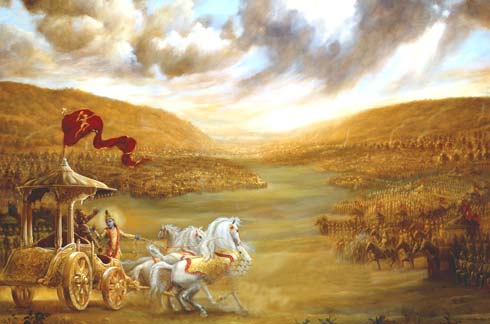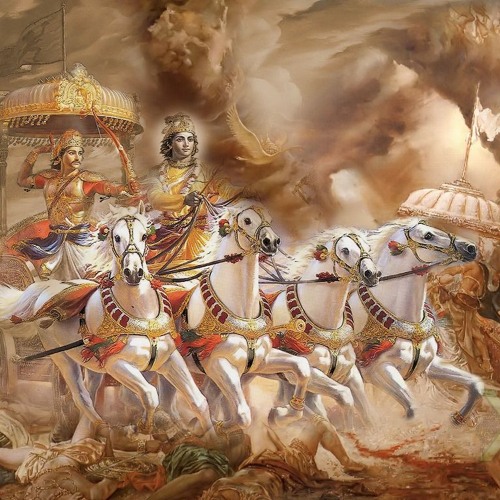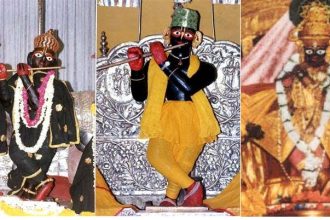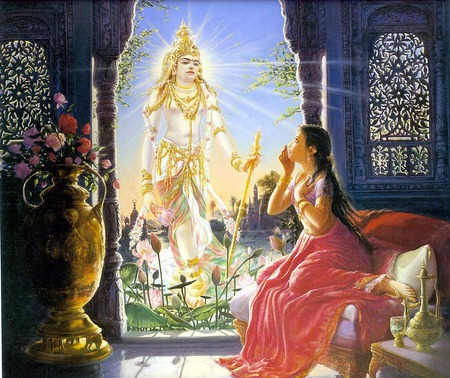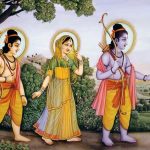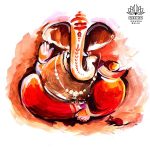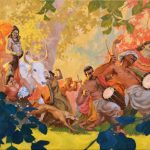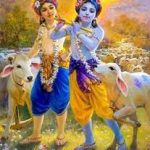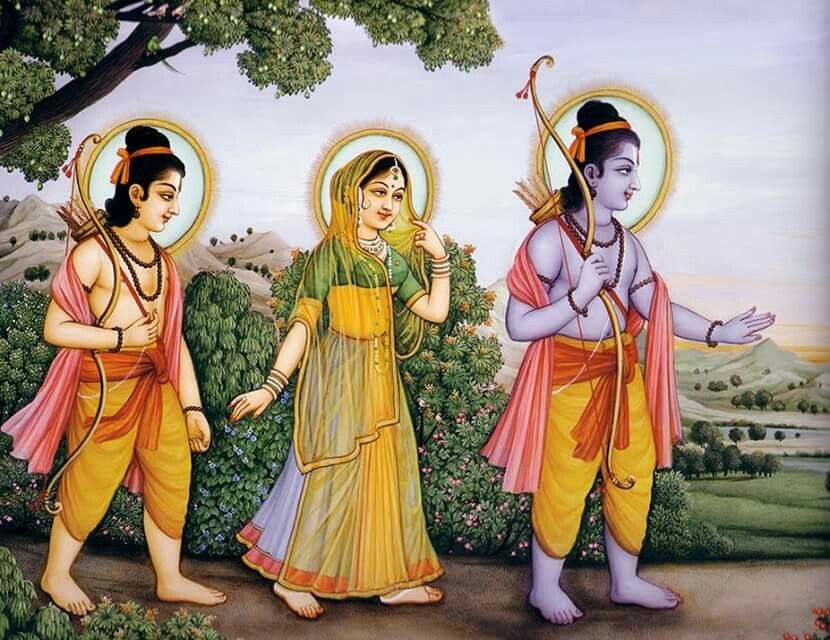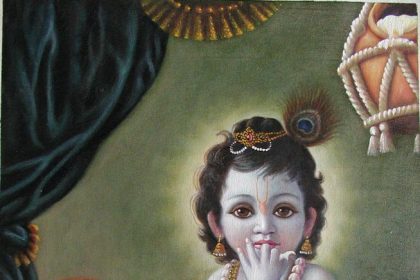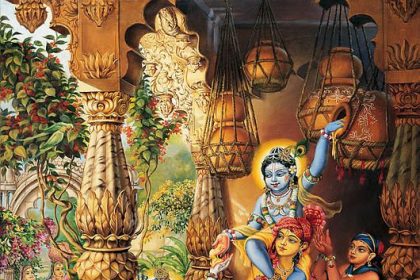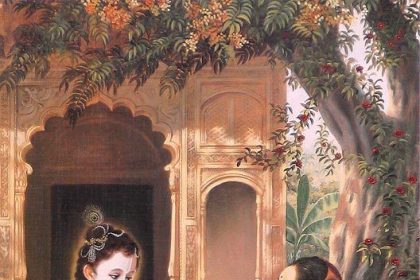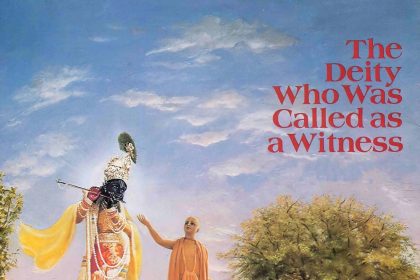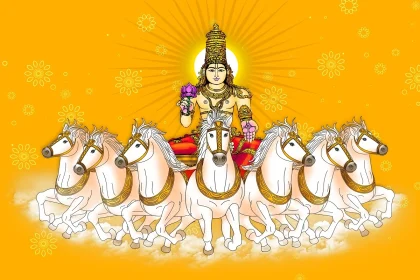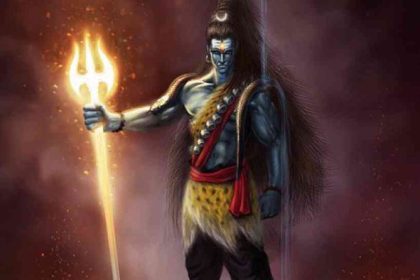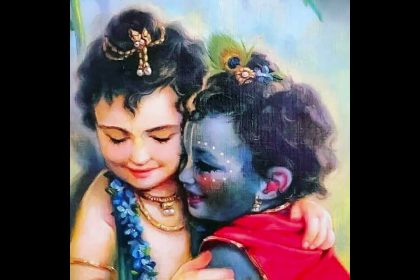Lord Brahmā lives in the highest planetary system, known as Brahmaloka or Satyaloka. In every planet there is a predominating deity. As the predominating deity in Satyaloka is Lord Brahmā, so in the heavenly planets Indra is the predominating deity, and on the sun, the sun-god, Vivasvān, is the predominating deity. The inhabitants and predominating deities of every planet are all recommended to worship Govinda either by meditation or by chanting.
(Sri Caitanya Caritamrta – 1:5:221 – purport).
In material consciousness, however, even one who is situated in the mode of goodness is susceptible to pollution by the modes of passion and ignorance. When the mode of goodness is mixed with the mode of passion, one worships the sun-god, Vivasvān. When the mode of goodness is mixed with the mode of ignorance, one worships Gaṇapati, or Gaṇeśa. When the mode of passion is mixed with the mode of ignorance, one worships Durgā, or Kālī, the external potency. When one is simply in the mode of ignorance, one becomes a devotee of Lord Śiva because Lord Śiva is the predominating deity of the mode of ignorance within this material world. However, when one is completely free from the influence of all the modes of material nature, one becomes a pure Vaiṣṇava on the devotional platform.
(Sri Caitanya Caritamrta – 2:24:330 – purport).
The Vedic knowledge was thus imparted unto the heart of Brahmā, the first living being in the material creation. It was Brahmā who related this knowledge to the sage Nārada Muni. Similarly, the Bhagavad-gītā was spoken by the Personality of Godhead, Śrī Kṛṣṇa, to Vivasvān, the presiding deity of the sun, and when the aural chain of disciplic succession was broken, Lord Kṛṣṇa repeated the Bhagavad-gītā to Arjuna on the Battlefield of Kurukṣetra. At that time, Arjuna took the role of disciple and student in order to receive transcendental knowledge from Śrī Kṛṣṇa. In order to drive out all misgivings which the gross materialists of the world may have, Arjuna asked all relevant questions, and the answers were given by Kṛṣṇa so that any layman can understand them. Only those who are captivated by the glamour of the material world cannot accept the authority of Lord Śrī Kṛṣṇa. One has to become thoroughly clean in habit and heart before one can understand the details of the antimaterial world. Bhakti-yoga is a detailed scientific transcendental activity that both the neophyte and the perfect yogī can practice.
(Easy journey to other Planets).
In this millennium, the sun-god is known as Vivasvān, the king of the sun, which is the origin of all planets within the solar system. In the Brahma-saṁhitā (5.52) it is stated:
yac-cakṣur eṣa savitā sakala-grahāṇāṁ
rājā samasta-sura-mūrtir aśeṣa-tejāḥ
yasyājñayā bhramati sambhṛta-kāla-cakro
govindam ādi-puruṣaṁ tam ahaṁ bhajāmi
“Let me worship,” Lord Brahmā said, “the Supreme Personality of Godhead, Govinda (Kṛṣṇa), who is the original person and under whose order the sun, which is the king of all planets, is assuming immense power and heat. The sun represents the eye of the Lord and traverses its orbit in obedience to His order.”
The sun is the king of the planets, and the sun-god (at present of the name Vivasvān) rules the sun planet, which is controlling all other planets by supplying heat and light. He is rotating under the order of Kṛṣṇa, and Lord Kṛṣṇa originally made Vivasvān His first disciple to understand the science of Bhagavad-gītā. The Gītā is not, therefore, a speculative treatise for the insignificant mundane scholar but is a standard book of knowledge coming down from time immemorial.
(Bhagavad-Gita – 4:1 – purport).
In the Mahābhārata (Śānti-parva 348.51-52) we can trace out the history of the Gītā as follows:
tretā-yugādau ca tato
vivasvān manave dadau
manuś ca loka-bhṛty-arthaṁ
sutāyekṣvākave dadau
ikṣvākuṇā ca kathito
vyāpya lokān avasthitaḥ
“In the beginning of the millennium known as Tretā-yuga this science of the relationship with the Supreme was delivered by Vivasvān to Manu. Manu, being the father of mankind, gave it to his son Mahārāja Ikṣvāku, the king of this earth planet and forefather of the Raghu dynasty, in which Lord Rāmacandra appeared.” Therefore, Bhagavad-gītā existed in human society from the time of Mahārāja Ikṣvāku.
(Bhagavad-Gita – 4:1 – purport).
Accepting that before the birth of Manu the Gītā was spoken by the Lord to His disciple the sun-god Vivasvān, a rough estimate is that the Gītā was spoken at least 120,400,000 years ago; and in human society it has been extant for two million years. It was respoken by the Lord again to Arjuna about five thousand years ago. That is the rough estimate of the history of the Gītā, according to the Gītā itself and according to the version of the speaker, Lord Śrī Kṛṣṇa. It was spoken to the sun-god Vivasvān because he is also a kṣatriya and is the father of all kṣatriyas who are descendants of the sun-god, or the sūrya-vaṁśa kṣatriyas.
(Bhagavad-Gita – 4:1 – purport).
The sunshine may expand all over the universe, but the source of the sunshine, namely the sun planet or the deity known as Sūrya-nārāyaṇa, is the basis of such radiation. Similarly, the Supreme Personality of Godhead Lord Kṛṣṇa is the basis of the impersonal brahmajyoti radiation, or the impersonal feature of the Lord.
(Srimad Bhagavatam – 2:6:17 – purport).
In each and every planet there is a predominating deity. It is understood from Bhagavad-gītā that in the sun there is a predominating deity named Vivasvān. Similarly, there is a predominating deity of the moon and of the various planets. Actually the predominating deities in all the other planets are descendants from the predominating deities of the sun and moon. On this planet earth there are two kṣatriya dynasties, and one comes from the predominating deity of the sun and the other from the predominating deity of the moon. These dynasties are known as Sūrya-vaṁśa and Candra-vaṁśa respectively. When monarchy existed on this planet, the chief member was one of the members of the Sūrya dynasty, orSūrya-vaṁśa, and the subordinate kings belonged to the Candra-vaṁśa. However, Mahārāja Pṛthu was so powerful that he could exhibit all the qualities of the predominating deities in other planets.
(Srimad Bhagavatam – 4:22:54 – purport).
As one Manu follows another, the cult of Kṛṣṇa consciousness is being imparted, as confirmed in Bhagavad-gītā (4.1):
śrī-bhagavān uvāca
imaṁ vivasvate yogaṁ
proktavān aham avyayam
vivasvān manave prāha
manur ikṣvākave ‘bravīt
“The Blessed Lord said: I instructed this imperishable science of yoga to the sun-god, Vivasvān, and Vivasvān instructed it to Manu, the father of mankind, and Manu in turn instructed it to Ikṣvāku.” Vivasvān, the sun-god, imparted Bhagavad-gītā to one Manu, and this Manu imparted it to his son, who imparted it to yet another Manu. In this way the propagation of Kṛṣṇa consciousness is never stopped. No one should think that this Kṛṣṇa consciousness movement is a new movement. As confirmed by Bhagavad-gītā and Śrīmad-Bhāgavatam, it is a very, very old movement, for it has been passing down from one Manu to another.
(Srimad Bhagavatam – 4:28:31 – purport).
The sunshine is light, the sun globe itself is light, and the sun-god is also light. However, the sunshine is not identical with the sun-god, Vivasvān. This is the meaning of simultaneously one and different (acintya-bhedābheda-tattva). All the planets rest on the sunshine, and because of the heat of the sun, they all revolve in their orbits. On each and every planet, the trees and plants grow and change colors due to the sunshine. Being the rays of the sun, the sunshine is nondifferent from the sun. Similarly, all the planets, resting on the sunshine, are nondifferent from the sun. The entire material world is completely dependent on the sun, being produced by the sun, and the cause, the sun, is inherent in the effects. Similarly, Kṛṣṇa is the cause of all causes, and the effects are permeated by the original cause. The entire cosmic manifestation should be understood as the expanded energy of the Supreme Lord.
(Srimad Bhagavatam – 4:31:16 – purport).
Śrīla Vīrarāghava Ācārya explains this verse of Śrīmad-Bhāgavatam as follows. The original cause of the cosmic manifestation must be the oldest person and must therefore be beyond material transformations. He is the enjoyer of all auspicious activities and is the cause of conditional life and also liberation. The demigod Sūrya, who is categorized as a very powerful jīva, or living entity, is a representation of one of the parts of His body. We are naturally subordinate to powerful living entities, and therefore we can worship the various demigods as living beings who are powerful representatives of the Supreme Personality of Godhead. Although the worship of the sun-god is recommended in this mantra, He is worshiped not as the Supreme Personality of Godhead but as His powerful representative.
(Srimad Bhagavatam – 5:20:5 – purport).
In this regard, Śrīla Viśvanātha Cakravartī Ṭhākura says, sūrya ātmā ātmatvenopāsyaḥ. The actual life and soul of all living entities within this universe is the sun. He is therefore upāsya, worshipable. We worship the sun-god by chanting the Gāyatrī mantra (oṁ bhūr bhuvaḥ svaḥ tat savitur vareṇyaṁ bhargo devasya dhīmahi). Sūrya is the life and soul of this universe, and there are innumerable universes for which a sun-god is the life and soul, just as the Supreme Personality of Godhead is the life and soul of the entire creation. We have information that Vairāja, Hiraṇyagarbha, entered the great, dull, material globe called the sun. This indicates that the theory held by so-called scientists that no one lives there is wrong. Bhagavad-gītā also says that Kṛṣṇa first instructed Bhagavad-gītā to the sun-god (imaṁ vivasvate yogaṁ proktavān aham avyayam (BG 4.1)). Therefore the sun is not vacant. It is inhabited by living entities, and the predominating deity is Vairāja, or Vivasvān. The difference between the sun and earth is that the sun is a fiery planet, but everyone there has a suitable body and can live there without difficulty.
(Srimad Bhagavatam – 5:20:46 – purport).
The sun-god, who controls the affairs of the entire universe, especially in regard to heat, light, seasonal changes and so on, is considered an expansion of Nārāyaṇa. He represents the three Vedas-Ṛg, Yajur and Sāma-and therefore he is known as Trayīmaya, the form of Lord Nārāyaṇa. Sometimes the sun-god is also called Sūrya Nārāyaṇa. The sun-god has expanded himself in twelve divisions, and thus he controls the six seasonal changes and causes winter, summer, rain and so on. Yogīs and karmīs following the varṇāśrama institution, who practice haṭha or aṣṭāṅga-yoga or who perform agnihotra sacrifices, worship Sūrya Nārāyaṇa for their own benefit. The demigod Sūrya is always in touch with the Supreme Personality of Godhead, Nārāyaṇa. Residing in outer space, which is in the middle of the universe, between Bhūloka and Bhuvarloka, the sun rotates through the time circle of the zodiac, represented by twelve rāśis, or signs, and assumes different names according to the sign he is in.
(Srimad Bhagavatam – 5:22 – summary).
The seventh Manu, who is the son of Vivasvān, is known as Śrāddhadeva. He has ten sons, named Ikṣvāku, Nabhaga, Dhṛṣṭa, Śaryāti, Nariṣyanta, Nābhāga, Diṣṭa, Tarūṣa, Pṛṣadhra and Vasumān. In this manvantara, or reign of Manu, among the demigods are the Ādityas, Vasus, Rudras, Viśvedevas, Maruts, Aśvinī-kumāras and Ṛbhus. The king of heaven, Indra, is known as Purandara, and the seven sages are known as Kaśyapa, Atri, Vasiṣṭha, Viśvāmitra, Gautama, Jamadagni and Bharadvāja. During this period of Manu, the Supreme Personality of Godhead Viṣṇu appears from the womb of Aditi in His incarnation as the son of Kaśyapa.
(Srimad Bhagavatam – 8:13 – summary).
Śrīla Viśvanātha Cakravartī Ṭhākura, an expert astrologer, explains the word nakṣatra-tārādyāḥ. The word nakṣatra means “the stars,” the word tāra in this context refers to the planets, and ādyāḥ means “the first one specifically mentioned.” Among the planets, the first is Sūrya, the sun, not the moon. Therefore, according to the Vedic version, the modern astronomer’s proposition that the moon is nearest to the earth should not be accepted. The chronological order in which people all over the world refer to the days of the week—Sunday, Monday, Tuesday, Wednesday, Thursday, Friday and Saturday—corresponds to the Vedic order of the planets and thus circumstantiates the Vedic version. Apart from this, when the Lord appeared the planets and stars became situated very auspiciously, according to astrological calculations, to celebrate the birth of the Lord.
(Srimad Bhagavatam – 8:18:5 – purport).
According to the Vedic system, the kṣatriya family is the protector of the human race. When the Supreme Personality of Godhead appeared as Lord Rāmacandra, He appeared in the sūrya-vaṁśa, the family descending from the sun-god, and when He appeared as Lord Kṛṣṇa, He did so in the Yadu dynasty, or yadu-vaṁśa, whose descent was from the moon-god. In the Ninth Canto, Twenty-fourth Chapter, of Śrīmad-Bhāgavatam, there is a long list of the kings of the yadu-vaṁśa. All the kings in both the soma-vaṁśa and sūrya-vaṁśa were great and powerful, and Mahārāja Parīkṣit praised them very highly (rājñāṁ cobhaya-vaṁśyānāṁ caritaṁ paramādbhutam). Nonetheless, he wanted to hear more about the soma-vaṁśa because that was the dynasty in which Kṛṣṇa had appeared.
(Srimad Bhagavatam – 10:1:1 – purport).


